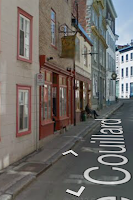I gave some thought as to what I was looking for. This was going to be all about getting a habit that would be working for me whether or not I was paying attention. Most of the steps we take are not about "getting activity" but about just moving around from "A to B". It's gratifying to see how many steps you take before you leave the house in the morning. So I wanted a pedometer which would give me credit for every step, without my having to remember to turn it on when I started doing serious walking. Also, the daily nature of my goal meant I wanted to start fresh every day, and needed my device to reset to zero at midnight on its own. I wanted one with a memory. This wasn't about competition with others, but it would make it interesting if I could assemble some history for myself.
When I went shopping, I found that pedometer devices cost a lot more than I expected. Also I realized that, even if I found one I could afford that just kept ticking over on its own, I would need to remember to wear it all the time if I wanted to capture those stray steps that added up to my day's activity. Then a friend reminded me that I am probably already carrying my smart phone around every waking hour. Ever since I stopped using a watch, I carry it in my pocket, even if I'm not using it for communication. So I started to research pedometer applications for Smart Phones. I was disappointed with the first pedometer application that I tried, which seemed geared to people doing sports, and needed to be turned on whenever I started doing a significant walk, since it framed it as a form of workout. It also relied on its own social networking site to provide motivation. Not for me.
Further research brought me to the "Moves", a free "activity tracking" application for iPhone and Android devices. It fulfilled the above wish list. In addition, it gives me a choice of looking at my activity in terms of calories burned, time spent walking, and distance, as well as in absolute steps. If I were to add cycling and running to my activity, it would automatically start recording those too, as distinct activities. Movement in a vehicle also gets on the map under the generic name "transport", but it is clear that you aren't getting any exercise benefit from that!
"Moves" works through a GPS based "storyline" map which the website describes as an "automatic diary of your life". I find that this is a powerful, highly focused, form of bio-feedback about what is working for me in terms of the set of small choices that end up making a day. Every time I update throughout the day I not only get a reading of how many steps I've accumulated so far, but also what I did (or didn't) do to achieve them. By comparing my activities on different days, I get useful information about what I am really doing to achieve the overall goal. I'm amazed at how engaged I am in achieving the "carrot" of the congratulatory message I receive first thing in the morning after I reach a new all-time record number of steps. And over time I'm walking more, without feeling I've been subjected to any "stick".
The application works by using GPS to measure location, as well as the accelerometer in the phone which measures pace and counts the jiggles in your pocket as your body moves. It will continue working as long as your phone is turned on, unless you go into the application settings and turn the tracking function off. Then it stops recording your steps till you re-enable it, showing the period of unrecorded activity as a blank "Moves off" section on your Storyline. I've chosen to leave it on all the time, and to enter the names of the locations I've stopped, such as the "Salmon 'n' Bannock" restaurant in the illustration, rather than leave the designation unidentified as something like "Place in Kitsilano". After all, the approximate location of a "place" could be found by a jealous spouse (if I had one), since tapping on the storyline shows the underlying actual route, shown on a street map.
I did spend some time on the Moves website, reading the Privacy Policy (linked here) and asking myself whether it adequately addressed my concerns regarding what it refers to as my "Personally Identifiable Information (PII)". I'm sort of surprised that I'm so comfortable with having data being recorded about every step I take, given my general attitude of resistance to the increasing reach of the Internet into our lives. I value the perspective I have from my "Came of Age Before Computers" view of both sides of the Digital Divide. In embracing "Moves", am I beginning to prescribe to the theory that the banality of my life, and the sheer size of the metadata that would need to be sifted (even if I were that interesting) is enough of a protection? From whom? I laugh, but also wince, at the ironic "Proof that Google is God" posted by the tongue-in-cheek "Church of Google" Maybe "They" have just found my price, in that I really, really, really want a no-brainer tool to help me to get into better shape. For free.
Here is a link to the "Moves" site where you can research it yourself. I welcome any comments.




